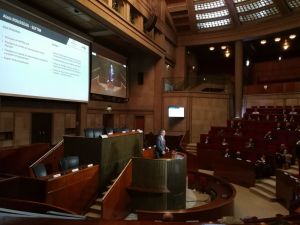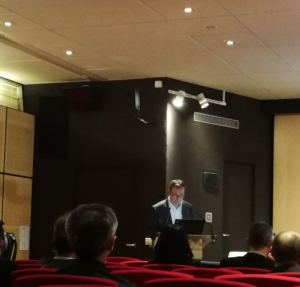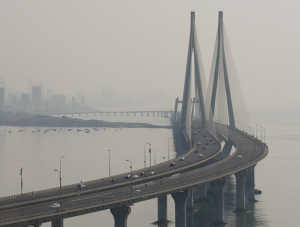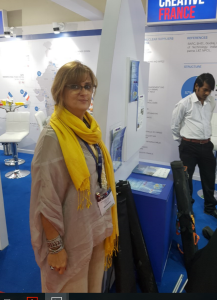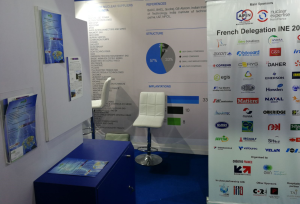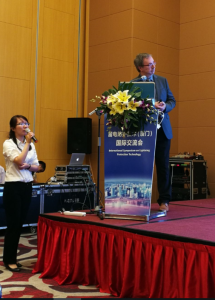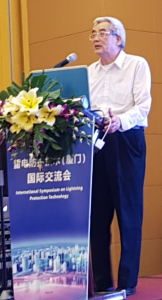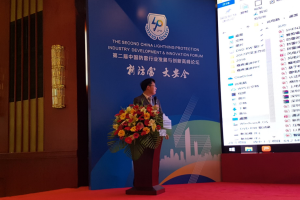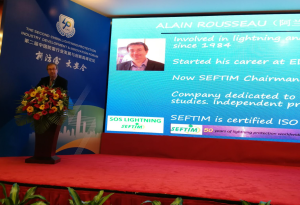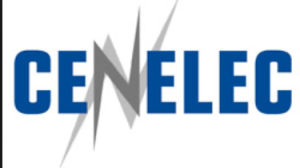 The permanent Secretariat of the European Standardization Committee (CENELEC) “Lightning protection” TC81X belongs to Italy. He attributed to our lightning expert Alain Rousseau the function of chairman of the 81X committee. It is an honor and a privilege to have been chosen by this Committee and this Secretariat whose level of requirement is known in particular to develop a lightning protection more and more rigorous. Alain Rousseau, succeeds to Christian Bouquegneau of the University of Mons, with whom SEFTIM has already done conferences on lightning and who has just retired. This post is also the right time to pay tribute to the work of Christian Bouquegneau not only in the field of standardization (IEC and CENELEC) but also for his scientific work and his work in the field of lightning in art or the history of Lightning.
The permanent Secretariat of the European Standardization Committee (CENELEC) “Lightning protection” TC81X belongs to Italy. He attributed to our lightning expert Alain Rousseau the function of chairman of the 81X committee. It is an honor and a privilege to have been chosen by this Committee and this Secretariat whose level of requirement is known in particular to develop a lightning protection more and more rigorous. Alain Rousseau, succeeds to Christian Bouquegneau of the University of Mons, with whom SEFTIM has already done conferences on lightning and who has just retired. This post is also the right time to pay tribute to the work of Christian Bouquegneau not only in the field of standardization (IEC and CENELEC) but also for his scientific work and his work in the field of lightning in art or the history of Lightning.
Feb 05
Chairmanship of the European Lightning Protection Standard Committee
Jan 18
Training in New Caledonia
Dec 12
ONSE
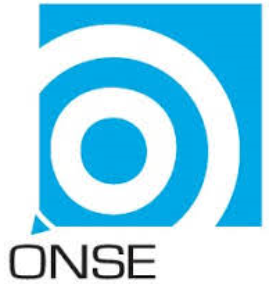 ONSE: In France, for more than 20 years, the association Promotelec and Consuel, supported by FASE (action fund for electrical safety), gathered actors committed to pool their data to analyse the evolution of electrical safety and improve it.
ONSE: In France, for more than 20 years, the association Promotelec and Consuel, supported by FASE (action fund for electrical safety), gathered actors committed to pool their data to analyse the evolution of electrical safety and improve it.
Each year, a plenary session, usually in December, provides an opportunity to present the work and results achieved in the relevant year by the ONSE Statistical Working Group.
The APF approached the ONSE with the aim of allowing the introduction of lightning data in the ONSE statistics. As such SEFTIM participated in the plenary session of 2017. http://www.onse.fr/ (in French)
Nov 23
30 years of Meteorage
 Métérorage, the French and international detection network, was celebrating its 30th anniversary this Thursday, November 23 in the prestigious premises of the Economic, Social and Environmental Council at the Palais d’Iéna in the 16th arrondissement of Paris.
Métérorage, the French and international detection network, was celebrating its 30th anniversary this Thursday, November 23 in the prestigious premises of the Economic, Social and Environmental Council at the Palais d’Iéna in the 16th arrondissement of Paris.
- After the emotionally charged introduction of Mr. Dominique Lapeyre de Chavardès, President of Météorage, Louis Bodin head of the weather service at RTL since 2002 and presenter of the weather reports on TF1 gave a very humanistic presentation on the weather and climate change. Météorage’s customers and partners then followed one another to explain their needs and then the shareholders Météo France and Vaisala to end up with a round table to answer the questions of the amphitheatre.
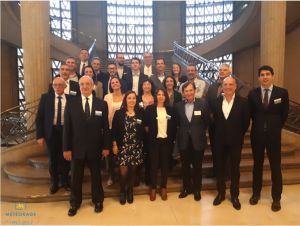 SEFTIM from its side, gave a short presentation focusing on 3 themes:
SEFTIM from its side, gave a short presentation focusing on 3 themes:
- Lightning Risk Analysis for which Météorage can provide lightning density in France and worldwide as well as data on the stormiest months, the statistical distribution of lightning currents and also the extreme currents.
- Expertise following an incident where Météorage can provide lightning impact data with the location, the amplitude of the lightning current and its timestamp.
- Standards: Météorage participates in standard activities (and in particular MT17 animated by SEFTIM) and carries out scientific publications to take into account the most relevant parameters of lightning strikes.
Nov 21
IEC TC81 MT 17 meeting in Austria
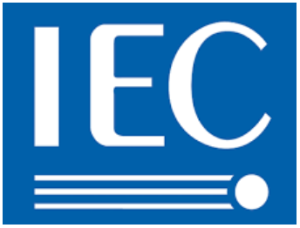 The second meeting of Working Group 17 in charge of storm detectors was held in Vienna on the premises of ALDIS, the Austrian Storm Detection Network (https://www.aldis.at/en/). SEFTIM is the leader of this working group.
The second meeting of Working Group 17 in charge of storm detectors was held in Vienna on the premises of ALDIS, the Austrian Storm Detection Network (https://www.aldis.at/en/). SEFTIM is the leader of this working group.
The aim of the working group is to publish edition 2 of IEC62793 (Thunderstorm Warning System) for storm detectors (networked: LLS Lightning Location Systems), local or grouped in a set of local sensors forming a mini-network. The classification of the various means of detection should be clearer and robustness tests which are for the moment only optional (and indeed very little performed) should become mandatory to ensure a longer life for the user and also reliable and validated information.
![]() The various parameters such as the lead time -time to clear), the number of lightning strikes not detected or the rate of false alarms should be specified with particular influence of each of these parameters on others, because obviously they are all related and improving one often means degrading others.
The various parameters such as the lead time -time to clear), the number of lightning strikes not detected or the rate of false alarms should be specified with particular influence of each of these parameters on others, because obviously they are all related and improving one often means degrading others.
As a reminder, the European standard EN 50536 on the same subject has recently been cancelled in favour of the IEC standard.
Nov 14
17th APF forum (French Lightning Protection Association)
Nov 10
Participation at INDIA NUCLEAR ENERGY 2017 in Mumbai INDIA
 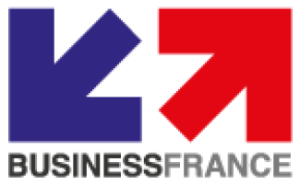 Following its development in India, SEFTIM participated this year at INE 2017 from 9th to 11th November, devoted to the nuclear industry in India (Nehru Center Mumbai). SEFTIM was present on the French pavilion organized by Business France. Following its development in India, SEFTIM participated this year at INE 2017 from 9th to 11th November, devoted to the nuclear industry in India (Nehru Center Mumbai). SEFTIM was present on the French pavilion organized by Business France.
See attached the catalog extract concerning SEFTIM.INE2017catalog_SEFTIM
http://aifen.fr/ (in French) http://giin.fr/ (in French) |
Oct 24
Seminars in China
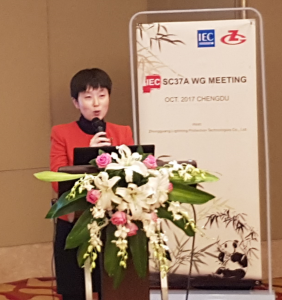 The working groups meeting of the IEC Surge Protective Device Committee (37A) in Chengdu (Sichuan) was also an opportunity to participate in two major events in China.
The working groups meeting of the IEC Surge Protective Device Committee (37A) in Chengdu (Sichuan) was also an opportunity to participate in two major events in China.
From 16 to 20 October, working groups 3 (application guide for LV surge arresters), 4 (telecom surge arresters), 5 (LV surge arresters) and 9 (new projects) met in Chengdu (known among other things for giant Pandas and Sichuan pepper) at the invitation of the company zhongguang (http://en.zhongguang.com/) with the aim of preparing the standards of tomorrow mainly in the field of DC surge arresters and the new organization of surge arresters standards BT (for the record, LV surge arresters standards will be transformed into a series 61643 including part 01 (general, applicable to all surge arresters), -11 (AC surge arresters), -21 (surge arresters data and telecom), 31 (surge arresters for photovoltaic applications) and 41 (DC surge arresters) Two new projects are being studied by the AHG09 group: surge arresters with additional functions (called SMART SPD) and specific disconnectors for surge arresters (SSD).
Note: a Low Voltage surge arrester is named Surge Protective Device
It should be noted that the meeting was held at the same time as the World Standards Day. Each year on 14 October, the members of the IEC, ISO and ITU celebrate World Standards Day, which is a means of paying tribute to the collaborative efforts of the thousands of experts worldwide who develop the voluntary technical agreements that are published as international standards. The theme of this year was « Standards make cities smarter » that matches very well with the « smart » SPD.
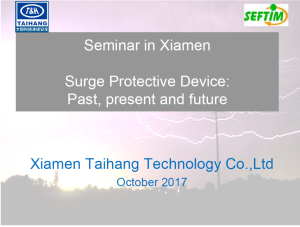 Following these meetings, SEFTIM participated in a conference organized by Taihang Technology in Xiamen (http://www.spd-th.com/?Language=EN). This conference (international symposium on lightning protection technology) which brought together more than 100 people from several provinces was an opportunity to discuss the future of surge arresters with presentations in fields as diverse as rail applications, detection of storms with Sinopec and the guidelines of the Ministry of Housing and Urban and Rural Development.
Following these meetings, SEFTIM participated in a conference organized by Taihang Technology in Xiamen (http://www.spd-th.com/?Language=EN). This conference (international symposium on lightning protection technology) which brought together more than 100 people from several provinces was an opportunity to discuss the future of surge arresters with presentations in fields as diverse as rail applications, detection of storms with Sinopec and the guidelines of the Ministry of Housing and Urban and Rural Development.
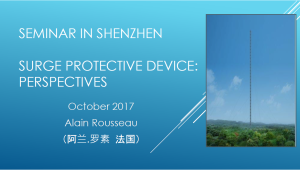 Finally, SEFTIM took part in the “second China lightning protection industry development & innovation forum” in Shenzhen. This event brought together more than 300 people from the entire lightning protection business in China, the people in charge of lightning protection and associated standards in the Ministry of Housing and Urban and Rural Development as well as experts from The Chinese meteorological administration, was an opportunity to discuss many innovative topics that clearly show the potential for Chinese innovation in this field.
Finally, SEFTIM took part in the “second China lightning protection industry development & innovation forum” in Shenzhen. This event brought together more than 300 people from the entire lightning protection business in China, the people in charge of lightning protection and associated standards in the Ministry of Housing and Urban and Rural Development as well as experts from The Chinese meteorological administration, was an opportunity to discuss many innovative topics that clearly show the potential for Chinese innovation in this field.
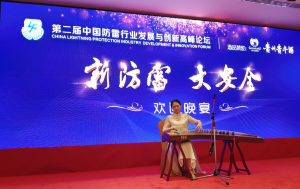 It is also interesting to note that China already has standards on SMART SPDs (surge arresters communicating about their state, their environment and their expected lifetime), SSD (special circuit breakers for surge arresters application able to withstand significant lightning surge while quickly cutting low fault currents), and multi-pulse tests (tests performed by injecting several pulses of low amplitude but consecutive which is very stringent especially for varistors).
It is also interesting to note that China already has standards on SMART SPDs (surge arresters communicating about their state, their environment and their expected lifetime), SSD (special circuit breakers for surge arresters application able to withstand significant lightning surge while quickly cutting low fault currents), and multi-pulse tests (tests performed by injecting several pulses of low amplitude but consecutive which is very stringent especially for varistors).
The presentations by SEFTIM focused on the coordination of SPD protection and the future of surge arresters as well as of the surge protective device committee.
Sep 19
International Colloquium on Lightning and Power Systems ICLPS 2017
 From 18 to 19 September, in Ljubljana (Slovenia), under the CIGRE organization, a 2-day conference on the impact of lightning on power systems. After two guest lectures various topics were discussed since the importance of thunderstorm detection networks, the experiment on HT surge arresters online, lightning ground measurement at the foot of pylons to transformer models for surge due to lightning simulation.
From 18 to 19 September, in Ljubljana (Slovenia), under the CIGRE organization, a 2-day conference on the impact of lightning on power systems. After two guest lectures various topics were discussed since the importance of thunderstorm detection networks, the experiment on HT surge arresters online, lightning ground measurement at the foot of pylons to transformer models for surge due to lightning simulation.
SEFTIM collaborated on a paper entitled “Characteristics and distribution of intense cloud-to-ground flashes in Western Europe” with Stephane Pedeboy from Météorage (France), Marina Bernardi from CESI (Italy) and Wolfgang Schulz from ALDIS-OVE Services (Austria ).
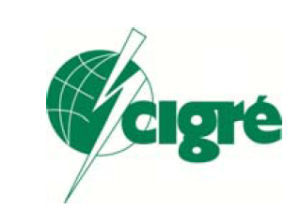 This work aimed at analysing the occurrence of Intense Cloud-to-Ground (ICG) in Western Europe, including a large part of maritime areas, defined as lightning flashes exhibiting at least one return stroke peak current larger than 200 kA based on lightning data collected by EUCLID between 2007 and 2016. As expected, the rate of ICG is low in average, about 0.18 % of the total Cloud-to-Ground (CG), but because of a pronounced seasonal trend it can increase up to 1.5% in winter. Around 70% of ICG occurring over the Atlantic Ocean and the Mediterranean Sea are of negative polarity whereas, in around the same proportion, they are positive over the continental regions. The geographical distribution of ICG shows a clear enhancement of ICG occurrences during winter time along coastal areas exhibiting elevated terrain, in northern Spain and western Italy and in Balkans. In these regions ICG are mainly located in land and surprisingly their polarity is negative on the contrary to the general trend stating most ICG are positive on the Continent. The discrepancies observed in the geographical, seasonal and polarity distributions are thought to be related to the different type of thunderstorms occurring across Europe and particularly oceanic and Mediterranean winter and continental deep-convective clouds. Finally, some high-density areas along Italian or Balkan coastlines can reach up to 0.45 ICG/km²/year, both polarities combined.
This work aimed at analysing the occurrence of Intense Cloud-to-Ground (ICG) in Western Europe, including a large part of maritime areas, defined as lightning flashes exhibiting at least one return stroke peak current larger than 200 kA based on lightning data collected by EUCLID between 2007 and 2016. As expected, the rate of ICG is low in average, about 0.18 % of the total Cloud-to-Ground (CG), but because of a pronounced seasonal trend it can increase up to 1.5% in winter. Around 70% of ICG occurring over the Atlantic Ocean and the Mediterranean Sea are of negative polarity whereas, in around the same proportion, they are positive over the continental regions. The geographical distribution of ICG shows a clear enhancement of ICG occurrences during winter time along coastal areas exhibiting elevated terrain, in northern Spain and western Italy and in Balkans. In these regions ICG are mainly located in land and surprisingly their polarity is negative on the contrary to the general trend stating most ICG are positive on the Continent. The discrepancies observed in the geographical, seasonal and polarity distributions are thought to be related to the different type of thunderstorms occurring across Europe and particularly oceanic and Mediterranean winter and continental deep-convective clouds. Finally, some high-density areas along Italian or Balkan coastlines can reach up to 0.45 ICG/km²/year, both polarities combined.
SEFTIM has also written in collaboration with Mitch Guthrie (USA) a paper “Risk assessment of lightning-induced surges on PV Systems” dealing with the risk due to overvoltages induced on photovoltaic systems (continuation of the paper on damage from direct lightning strikes presented at APL 2017 in Thailand).
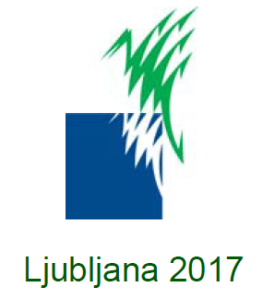 This paper applies the risk method of IEC 62305-2 to PV systems and derives a simplified method to determine Surge Protective Devices are needed or not especially on the DC side of the inverter taking into account loss of production. The method is based on the length of DC cabling and the flash ground density and lead to a table based on 3 typical cases. The hypotheses have been provided by real users and installers, as well as their associations. When necessary, these hypotheses have been formatted in such a manner that the method described in IEC 62305-2 applies. When a Lightning Protection System is implemented on a building supporting a PV system, the determination of the need of SPDs is purely academic and not related to risk analysis. As such, this case will not be addressed in the present study. Three main cases have been selected as representative of PV systems. PV for domestic application, PV on an office building and a PV farm. This study only addresses the risk of induced surges to PV systems due to indirect strikes in the vicinity of the system.
This paper applies the risk method of IEC 62305-2 to PV systems and derives a simplified method to determine Surge Protective Devices are needed or not especially on the DC side of the inverter taking into account loss of production. The method is based on the length of DC cabling and the flash ground density and lead to a table based on 3 typical cases. The hypotheses have been provided by real users and installers, as well as their associations. When necessary, these hypotheses have been formatted in such a manner that the method described in IEC 62305-2 applies. When a Lightning Protection System is implemented on a building supporting a PV system, the determination of the need of SPDs is purely academic and not related to risk analysis. As such, this case will not be addressed in the present study. Three main cases have been selected as representative of PV systems. PV for domestic application, PV on an office building and a PV farm. This study only addresses the risk of induced surges to PV systems due to indirect strikes in the vicinity of the system.
Aug 12
Mission to India
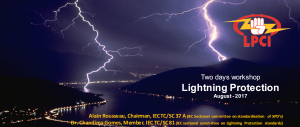 From August 1 to 11, 2-day workshops were held in different Indian cities:
From August 1 to 11, 2-day workshops were held in different Indian cities:
2nd and 3rd August – Mumbai
4th and 5th August – Chennai
8th and 9th August – Bangalore
10th and 11th August – Delhi
This 2-day workshop organised by S.Gopa Kumar of CAPE Electric and K.V.Varadharajan of LPCI (LP Consultants International www.lpci.in ), was designed to cover the important design and installation techniques which will be highly beneficial to engineers working in Industrial, Aviation, Military, Insurance, Power, Communication sectors, Hydrology & meteorology and who provide electronic, IT equipment and services and other institution or individuals interested in the above subject. 2 Days Training Programe on Lightning Protection Invitation Letter
Presentations were made by Professor Chandima Gomes from Malaysia and Alain Rousseau from SEFTIM.
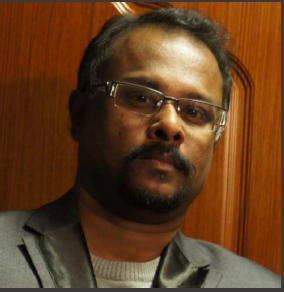
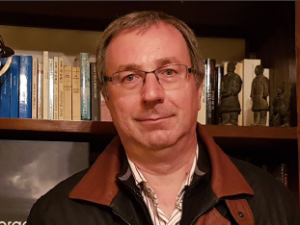 Mr. Chandima Gomes is a professor of electrical engineering and researcher in high voltage engineering and lightning protection at University Putra Malaysia. He is also an expert in power and energy, electromagnetic interference and compatibility and occupational safety management.
Mr. Chandima Gomes is a professor of electrical engineering and researcher in high voltage engineering and lightning protection at University Putra Malaysia. He is also an expert in power and energy, electromagnetic interference and compatibility and occupational safety management.
The following main themes were discussed:
- Lightning initiation, attachment and return stroke, characteristic and statistics, multiplicity, types of lightning, induced voltages, lightning measurements, triggered lightning, laboratory simulations, current models.
- Risk analysis, Introduction to standards & recommendations, calculation of lightning risk factors and recommendation of the level of protection.
- Designing and positioning of air-termination and down conductor systems, materials and dimensions. Designing of earth network, Equipotential bonding, Use of reinforcement steel and foundation earth for lightning protection, installation technologies, isolated protection systems, special issues of earthing, Site inspection and maintenance. Designing of LPS for different type of structures
- Protection of Low Voltage Electrical Systems: Need for protection, Lightning Protection Zonal concept, coupling mechanisms, Lightning and switching impulses, protection scenario, wiring systems for buildings, mode of protection, peak current handing capacity, let-through voltage, follow current, classes of surge protectors, SPD selection criteria, testing procedures.
- Earthing: IEC and IEEE standards. LV networks, system earthing, equipment earthing. Separate systems connected in a single low impedance earthing system. Low resistance connection to an earthing system.
- Selected Cases: Protection of Oil refineries, Explosive storage, Wind turbines, thermal power plants
- Human safety and safety guidelines: Statistics of lightning accidents, direct strikes and side flashes, step potential, touch potential, international guidelines, health hazards, recommendations for outdoor workers, safety devices.
Each of the workshops brought together 40 to 50 people with many questions.



